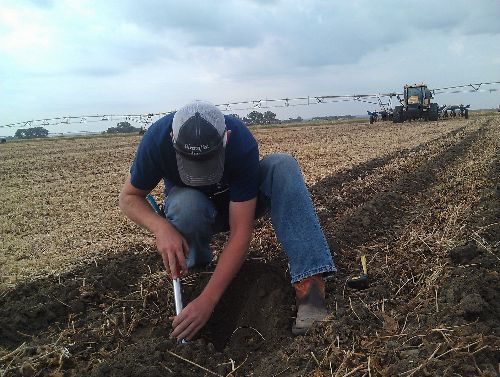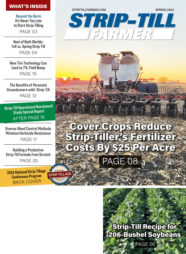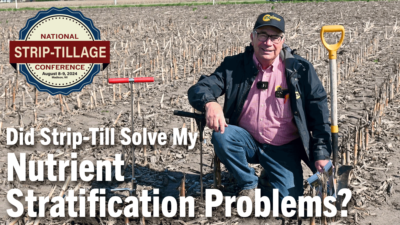While many farmers purchase and maintain their own strip-till rigs, some prefer an alternative approach to adopting the practice.
Custom strip-tilling is an emerging business in parts of the U.S., and can be a cost-effective option for new strip-tillers to get started with the practice.
Farmers offering custom strip-till services say, the key to success is flexibility, preparation, and an understanding that good results keep customers coming back.
Gaining Ground
Buckingham, Iowa, strip-tiller Adam Nechanicky started custom strip-tilling several years ago on about 300 acres for a neighbor wanting to move away from conventional tillage without purchasing new equipment.
“A lot of guys don’t want to spend the $100,000 to buy their own strip-till unit and would rather hire someone else so they can try strip-till for a year or two,” he says. “But the fact that farmers are looking for an alternative farming practice, and getting away from conventional tillage, is creating more opportunity for us to offer custom services.”
|
Elk Point, S.D., strip-tiller Joey Hanson shares the benefits and challenges of custom strip-tilling and how working on a variety of soil types, field sizes and with different equipment has helped evolve and improve his strip-tilling methodology. |
Nechanicky and his dad, Mark, strip-till about 500 acres of corn and no-till soybeans on their family farm. A few years ago, he purchased a 16-row Progressive toolbar with Remlinger row units and a mounted 6-ton Montag dry fertilizer bin with the intention of increasing his custom strip-till business.
But he admits there was some risk in purchasing a larger unit with no guarantee of picking up more custom acres. They spent $35,000 on the toolbar and another $12,000 on the row units, which Nechanicky considered investments in the custom business.
They also purchased a Caterpillar Challenger tractor with tracks to pull the unit, because they couldn’t pull the unit as fast as they wanted with their other tractor.
“We had been topping out at 4½ mph on the hills, which isn’t fast enough to cover custom acres,” Nechanicky says. “Last spring, the slowest we ran was 5½ mph because we improved our hydraulic capacity from 20 to 30 gallons per minute up to 60, which allowed us to evenly apply the fertilizer from our dry box as we moved through the field.
 CUSTOM CAPABILITY. Elk Point, S.D., farmer Joey Hanson custom strip-tills about 3,000 acres and says one key to his success is adapting his 12-row Thurston Mfg./Blu-Jet Legacy to suit various field conditions in fall.
Photo Courtesy of Joey Hanson
|
“We kind of put the cart before the horse, but we knew that if we didn’t have the right equipment, we weren’t going to cover enough acres to make it worthwhile. Luckily, through word-of-mouth and good results, we’ve been able to grow our business.”
Today, Nechanicky custom strip-tills about 1,500 acres, and with little competition in his part of east-central Iowa he hopes to grow the business further. With a lot of larger farming operations in the area, Nechanicky says, operators are primarily concerned with getting their own fields prepared for planting.
“They don’t have time to dedicate to custom strip-till, but I try to make sure my service is affordable,” he says. “I base my price on what it would cost to conventionally till a field, with a broadcast application of fertilizer, which is about equal to what I charge for strip-till in one pass.” In addition, he takes into account rates published in the Iowa State University Custom Rate Survey.
Nechanicky started out charging $20 per acre and has incrementally increased his rate to reflect rising fuel costs, rather than a dramatic one-year jump, so farmers don’t get “sticker shock.” Today, he charges $25 per acre for custom strip-till.
Adapting To Conditions
One of the keys to successful custom strip-tilling is accommodating a variety of soil types and field conditions to get the work done, says Joey Hanson, of Elk Point, S.D. — located in the southeastern part of the state. Hanson custom strip-tills about 3,000 acres in parts of Nebraska, Iowa and South Dakota and also owns a crop consulting business, Diversified Agronomy.
“I deal with a lot of variability, sometimes 20 to 25 different soil types, so I need to make sure I have a strip-till rig that is going to meet the challenges of each farmer’s field,” Hanson says. “I can’t just pull into every field and expect the same setup to work all the time.”
 PLAYING THE FIELD. One of the biggest challenges Hanson encounters with custom strip-till is dealing with 20 to 25 different soil types he strip-tills into each year.
Photo Courtesy of Joey Hanson
|
This is a lesson Hanson learned last year running his 12-row Thurston Mfg./Blu-Jet Legacy strip-till rig with a 9-ton Montag twin-bin fertilizer cart. Particularly wet conditions last fall made it difficult to get fall strips built in heavy clay soils, and Hanson’s rig paid the price.
“I did one 100-acre field for a customer last fall and broke 25 shear bolts. It was a nightmare,” Hanson says. “The strips ended up turning out fine, but what I learned is that when I’d leave one location for another 3 miles down the road, the soil conditions changed, but I didn’t account for that with my rig.”
Going into last fall, Hanson says he was pretty confident on the first few hundred acres that he had the perfect machine. About 1,000 acres in, he realized he didn’t and needed to make some changes to cover acres in a timely manner each year. He recently changed out a heavy, wavy coulter on the row units for a slightly fluted coulter, which is thinner and less aggressive to pull.
“It’s still a 20-inch coulter, but the difference is in the thickness,” Hanson says. “The wavy coulter flared out about 3 inches, where as now, there’s maybe a half-inch width on the flutes, which gives me more flexibility in changing field conditions.”
Hanson also changed out all of the knives on his row units to prevent drift in the machine. It’s not something farmers may think of doing on a 12-row, 30-foot rig, but Hanson says he was starting to notice some drift and wanted even wear on all of the knives.
“Building that nice strip with a raised berm, and an ideal seedbed to plant into for customers, is the objective,” he says. “This year, it’s been nice to see the consistency of the strip-till emergence. As long as I adapt to conditions I’m going into on a year-by-year or even field-by-field basis, I think I’ll be successful.”







Post a comment
Report Abusive Comment